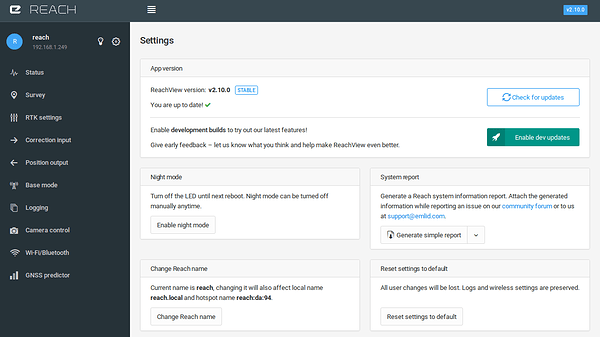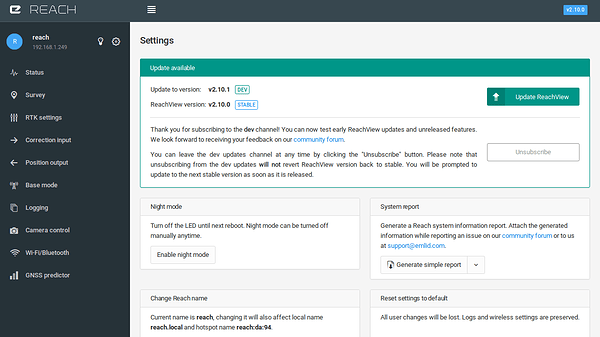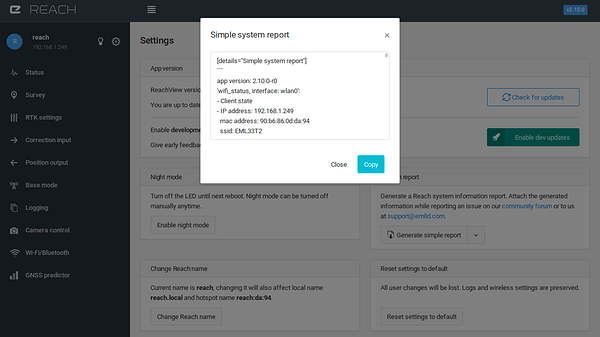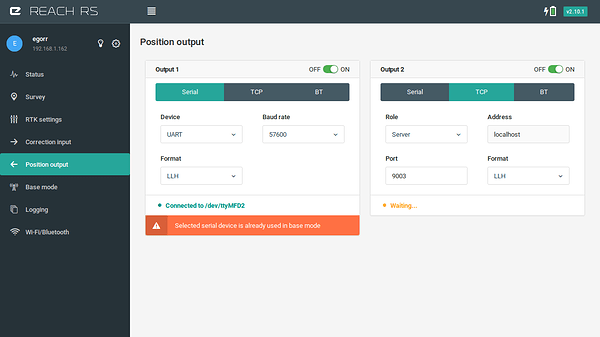Hello everyone,
It’s been some time since our last update, so today we have two new releases. They are slightly different in both features and their purpose.
Starting today, we are going to have two different ways to receive updates: a stable channel and a development channel. If you subscribe to the dev builds, you will start getting new features and fixes faster. The caveat is that they might not be completely stable before being released. Once we get some feedback from you guys, the feature will be considered stable and released for everybody.
Why do this? I’ve been working on Reach from the very beginning and have seen it evolve from a crowdfunding campaign to a full blown consumer product. Then Reach RS came and I started seeing Reach more and more in professional applications. Integrated in other products or used by professional surveyors, this is a different level of responsibility for the software team. The team, on the other side, still needs to move fast. So, it was decided to split the updates in two channels.
Features
- Ability to switch between stable and dev updates. “Check for updates” button included!
Warning: once you update to a dev build, you will not be able to revert back to stable until the next stable release. In case you absolutely have to revert, you will need to reflash.
Switching to the dev channel paints your updates in a nice green hue 
-
“System reports” to facilitate describing your problems to the community and to us. There are two kinds: one in plain text, and one as a zip archive. The former is for the forum, and makes it really easy to share the usual stuff like your settings, network state and app version. The latter is for harder cases and contains system logs and technical details of your device.
You can now simply copy your device’s settings with one click and paste it to the forum, instead of posting screenshots.
Click this guy  for a preview
for a preview
Simple system report
app version: 2.10.1-dev-r0
'wifi_status, interface: wlan0':
- Client state
- IP address: 192.168.1.162
mac address: 90:b6:86:0a:dd:52
ssid: EML33T2
base mode:
base coordinates:
accumulation: '2'
antenna offset:
east: '0'
north: '0'
up: '0'
coordinates:
- '0'
- '0'
- '0'
format: llh
mode: single-and-hold
output:
enabled: true
format: rtcm3
path: serial://ttyMFD2:57600:8:n:1:off#rtcm3
type: serial
rtcm3 messages:
'1002':
enabled: true
frequency: '1'
'1006':
enabled: true
frequency: '0.1'
'1008':
enabled: false
frequency: '1'
'1010':
enabled: true
frequency: '1'
'1019':
enabled: false
frequency: '1'
'1020':
enabled: false
frequency: '1'
'1097':
enabled: false
frequency: '1'
'1107':
enabled: false
frequency: '1'
'1117':
enabled: false
frequency: '1'
'1127':
enabled: false
frequency: '1'
bluetooth:
discoverable: false
enabled: false
pin: '***'
correction input:
input2:
enabled: true
format: rtcm3
path: ttyMFD2:38400:8:n:1:off
send position to base: 'off'
type: serial
input3:
enabled: false
format: rtcm3
path: :9028
type: tcpsvr
logging:
base:
format: RTCM3
started: true
version: null
correction:
format: RTCM3
started: true
version: null
interval: 24
overwrite: true
raw:
format: UBX
started: true
version: null
solution:
format: LLH
started: true
version: null
lora:
air rate: '18.23'
frequency: 868200
output power: '14'
position output:
output1:
enabled: true
format: llh
path: ttyMFD2:57600:8:n:1:off
type: serial
output2:
enabled: true
format: llh
path: :9003
type: tcpsvr
output3:
enabled: true
format: llh
path: :2014
type: tcpsvr
output4:
enabled: true
format: llh
path: :2015
type: tcpsvr
rtk settings:
elevation mask angle: '15'
glonass ar mode: 'off'
gps ar mode: fix-and-hold
max horizontal acceleration: '1'
max vertical acceleration: '1'
positioning mode: kinematic
positioning systems:
compass: false
galileo: false
glonass: true
gps: true
qzs: true
qzss: true
sbas: true
snr mask: '35'
update rate: '5'
Warning: the Android/iOS apps support the full system report feature starting with version 1.2. These versions are currently being rolled out to both stores.
- Peru users will now have their LoRa frequency bands automatically limited to a 915100 - 927900 kHz range
Bugfixes
- RCH-886 - After losing network connection in client mode, Reach will no longer be “stuck” connected to nothing, but will be actively reconnecting to the missing network
- RCH-889 - Support for GLONASS MSM 1084, which does not contain the satellites’ frequencies
- RCH-874 - No longer write L2 flags to the Reach-generated RINEX file header
- RCH-809 - Changing device name does not produce a reaction in the app
- RCH-859 - Fix DNS not working with certain types of USB modems
- RCH-894 - Another fix for working with QZSS corrections
- RCH-714 - The “@” symbol breaks NTRIP configuration screen, if used in username or password. The “:” and “/” symbols are still forbidden!
Dev update features
This dev release already has some new cool stuff to lure you guys in 
- Position output tab rewritten from the ground up
- Second position output is back
- The new forms have a fancy new validation system. Warnings with detailed messages will make Reach configuration less error-prone
- Additional correction and GNSS predictor are deprecated
- RCH-863 - ‘GNSS select’ will no longer allow users to set up GLONASS/BEIDOU with update rate > 5 Hz
- RCH-787 Turning on BEIDOU if GLONASS was previously on does not work
We see all this preparation work as a foundation for faster growth. At the same time, this will protect users that rely on Reach in their day-to-day work.
Best regards,
Emlid team









